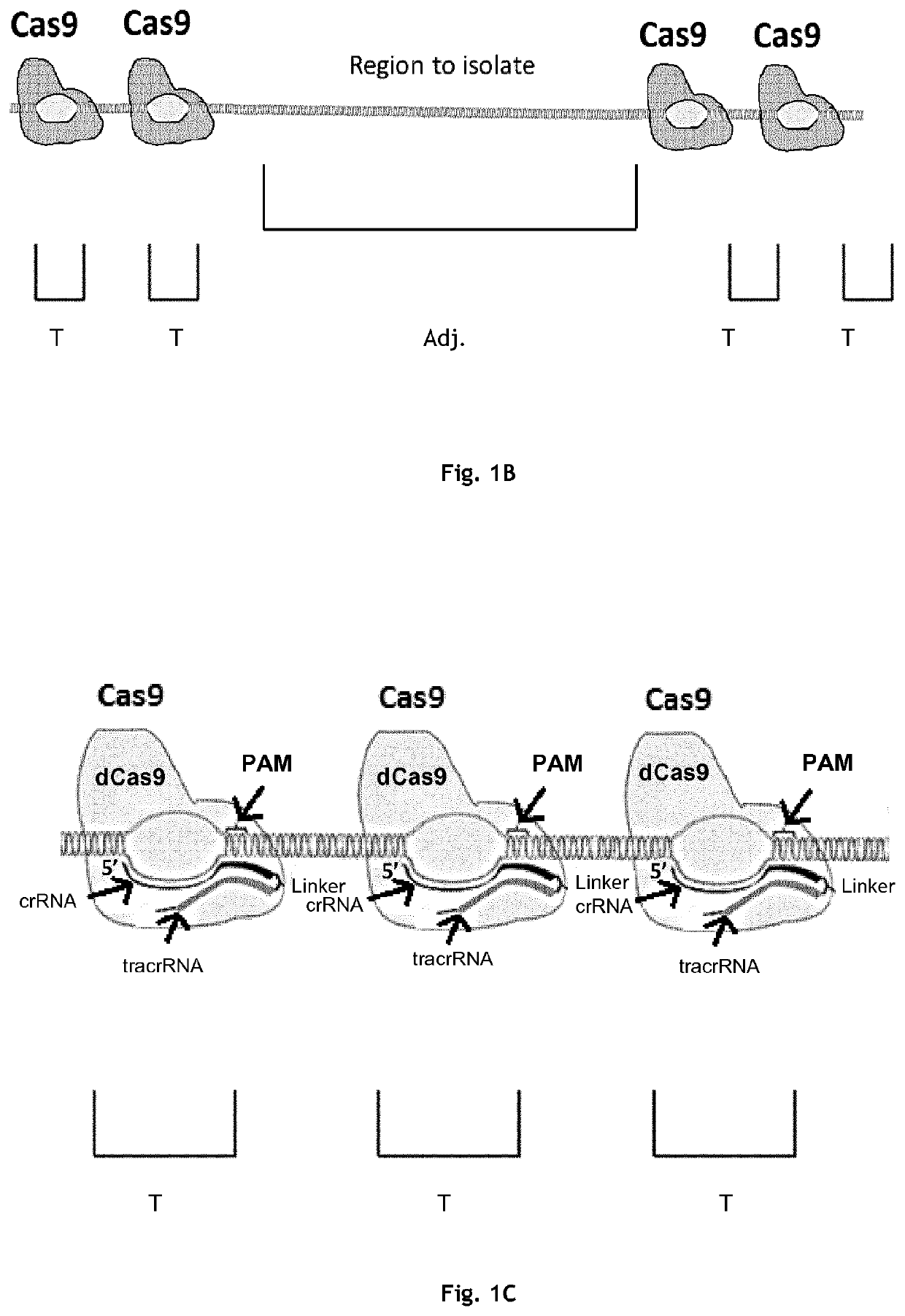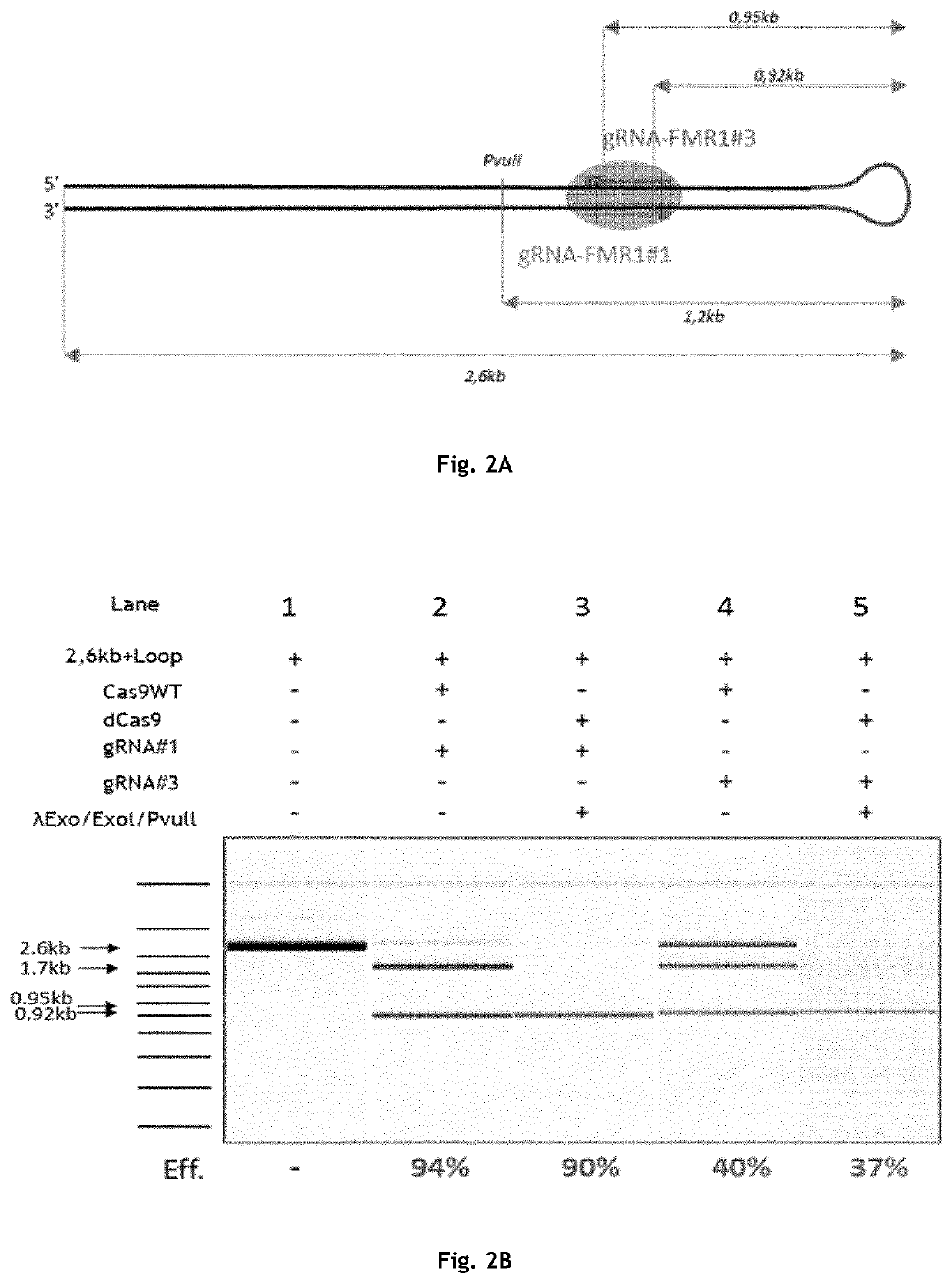In vitro isolation and enrichment of nucleic acids using site-specific nucleases
- Summary
- Abstract
- Description
- Claims
- Application Information
AI Technical Summary
Benefits of technology
Problems solved by technology
Method used
Image
Examples
example 1
of the Guide RNA
[0223]Guide RNA(s) are synthesized in vitro using a viral transcriptional system (for example, T7, SP6 or T3 RNA polymerase) or chemically produced using automated synthesizer. In some cases, a universal tracrRNA (SEQ ID NO: 25) may be annealed to the target specific crRNA (generic sequence shown in SEQ ID NO: 24), as is further detailed in section 9.3. Three Cas9 guide RNAs flanking a region of approximately 0.9 kb within a 4 kb DNA plasmid (pPS009, SEQ ID NO: 1) containing the Fmr1 locus (SEQ ID NO: 2) were designed (gRNA-Fmr1#1, gRNA-Fmr1#2 and gRNA-Fmr1#3 having the sequences of SEQ ID NO: 3, 4 and 5, respectively). For each gRNA, efficiency was tested in vitro on a standardised / controlled sample (e.g. PCR fragments) using the wild type Cas9 nuclease. This is to ensure that each Type II Cas protein-gRNA complex can cut the expected target region comprising a sequence complementary to the gRNA with a reasonable efficiency, (e.g. of at least 50%, 60%, 70%, 80%, 90%...
example 2
eaction Protocol
[0224]1. The Type II Cas protein is loaded with gRNA by incubation for 10 minutes at room temperature (e.g. 25° C.) in Type II Cas protein reaction buffer (20 mM Tris-acetate, 10 mM Magnesium acetate, 50 mM Potassium acetate, 100 μg / ml BSA, 0.1% Triton X-100 (pH 7.9)).[0225]2. A sample comprising nucleic acid molecules is added to the mixture of step 1, and incubated for 1 hour at 37° C. in order to allow the Type II Cas protein-gRNA complex to bind to the target region.[0226]3. A mixture of exonuclease(s) (e.g. lambda exonuclease) and restriction enzyme(s) are added and the mixture is incubated for 1 hour at 37° C. Enzymes are then inactivated at 75° C. for 15 minutes.[0227]4. RNaseA (optionally) and Proteinase K treatments are performed successively for 15 minutes at 37° C. to remove the Type II Cas protein-gRNA complex from the target region. Alternatively, or in addition, the reaction can be supplemented with EDTA to stop the reaction, thereby removing the Type I...
example 3
as Protein-gRNA Complex Binding Protects the Target Region from Exonuclease Digestion
[0228]Exemplary embodiments of Type II Cas protein-gRNA complex binding to a nucleotide fragment comprising one or more target regions and, optionally, an adjacent region of interest, are shown in FIG. 1. In some cases, a single Type II Cas protein-gRNA complex may be used to protect a target region (cf. FIG. 1A). As illustrated in FIG. 1A, the Type II Cas protein-gRNA complex comprising dCas9 protects a region that comprises the gRNA sequence. Mismatches between the target region and the gRNA located within at positions -1 to -6 relative to the PAM sequence strongly reduce protection when using only a single dCas9-gRNA complex to protect the target region. In particular, mismatches at the bases located 4, 5, or 6 bases from the PAM reduce protection by 4.8 to 12-fold. Protection may be even more strongly reduced or even abolished when Type II Cas proteins having greater binding specificity (e.g. Ca...
PUM
| Property | Measurement | Unit |
|---|---|---|
| Fraction | aaaaa | aaaaa |
| Fraction | aaaaa | aaaaa |
| Fraction | aaaaa | aaaaa |
Abstract
Description
Claims
Application Information
 Login to View More
Login to View More - R&D
- Intellectual Property
- Life Sciences
- Materials
- Tech Scout
- Unparalleled Data Quality
- Higher Quality Content
- 60% Fewer Hallucinations
Browse by: Latest US Patents, China's latest patents, Technical Efficacy Thesaurus, Application Domain, Technology Topic, Popular Technical Reports.
© 2025 PatSnap. All rights reserved.Legal|Privacy policy|Modern Slavery Act Transparency Statement|Sitemap|About US| Contact US: help@patsnap.com



